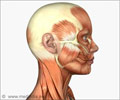Recent studies on mice reveal that a drug, being tested as an anticancer agent to treat breast cancer, supports recovery from muscular dystrophy, a disease that has no cure
Recent studies on mice reveal that a drug, being tested as an anticancer agent to treat breast cancer, supports recovery from muscular dystrophy, a disease that has no cure.
Duchene muscular dystrophy is a disease characterized by progressive weakness and degeneration of the muscles that control movement. According to earlier studies, the functional decline of "dystrophic" muscles can be slowed down by agents that enhance muscle fiber size.The recent study conducted by Dr. P. L. Puri, from The Burnham Institute in La Jolla, California, and colleagues is published on line yesterday in the journal Nature Medicine. According to this study, the anticancer drug trichostatin A or TSA increases muscles fiber size in two mouse models of muscular dystrophy. Mice with this disability, when given TSA for 3 months, were able to run on treadmills and swim as long as healthy mice. According to the researchers, the drug caused no obvious side effects or signs of toxicity. TSA belongs to a class of drugs called deacetylase inhibitors.
The dystrophic muscles became resistant to contraction-related degeneration when treated with trichostatin A and this is linked with functional and morphological recovery. "We have identified a new rationale for treating muscular dystrophy, aimed at correcting the devastating effects of a single flawed gene," Dr Lorenzo Puri said in a statement. "In the window of time that we have analysed these mice, they seem to perform like normal mice. All the decreases in muscle performance were restored by the treatment. "This is a significant advance over the use of steroid -- currently the only treatment available -- which offers palliative relief, often with severe side effects," he said.
Ms Sharon Hesterlee, a vice-president of the association, which helped finance the research, said "I am hesitant to call the finding a breakthrough, because that could raise expectations unfairly, but it's certainly an important finding."
Puri said, "Extensive investigation is now required to determine if these animal findings also apply to humans with muscular dystrophy. It is difficult to predict how long it will take before these studies will be translated into therapies for human patients," he added. "The next step is to test TSA on larger animals, such as golden retrievers, which contract a form of muscular dystrophy more similar to that in humans, " Dr Puri said.
One in every 3,500 male births is affected by this inherited disease. According to the Muscular Dystrophy Association, 40,000-60,000 people in the US have some form of the inherited disease.
Advertisement
GYT








